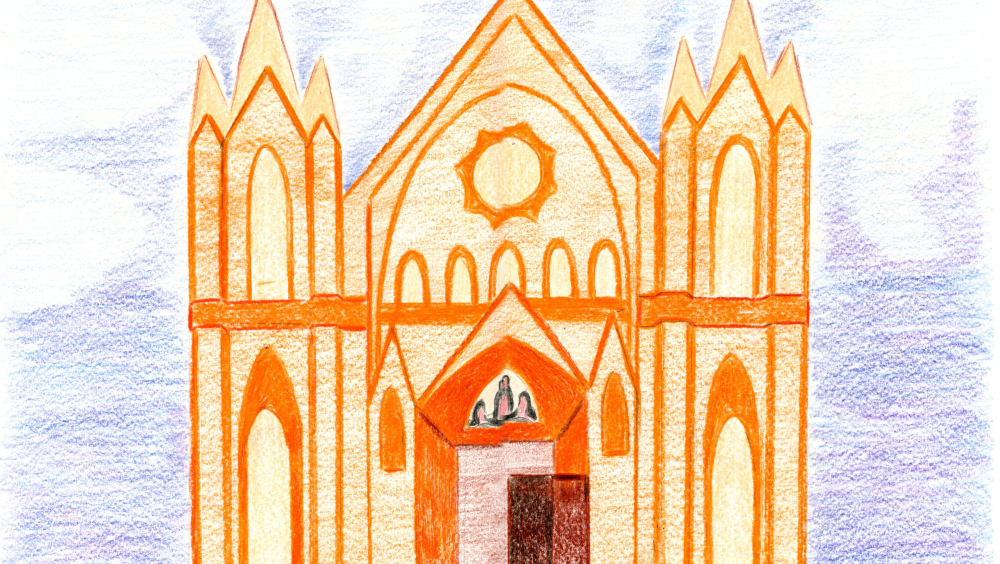Church of fifteen languages
Overview
Church of fifteen languages
Objects of cultural heritage (for example, works of architecture, monumental sculpture and painting, ensembles, estates), are parts of world history, reflecting values and traditions of different cultures and nations all over the world from ancient times and up to now.
In the territory of Kursk Region - my native land, the Polish Catholic Church, better known as the Temple of the Dormition of the Mother of God, is located. The church functions as a Catholic temple and is opened to the publicity. Father Georgy Matuzza is the founder of this church. The temple was built in neogothic style (1986) unique lines of which are reflected in two steeple-like towers, twenty seven gilded crosses located on the portal and on each side of the temple, and rich mosaic. Considering the fact that neogothic style, originated in the 40s of the 18th century in England, was not widely recognized in Russia, the temple is a rare representative of European cultural heritage. The history of the temple is also remarkable due to the fact that a world famous artist - K. Malevich got married and christened his daughter there.
European Heritage is a set of objects, both cultural and architectural, which represent s not only the history of development of countries and nations, living in Europe, but also supreme values included in them and necessary for harmonious and civilized functioning of modern society. Pieces of inner apparel (decor) are considered as objects of cultural diversity, common both for Russia and Europe: Madonna and Jesus Christ’s sculptures, Jesus Beneficent’s icon which was brought from Krakow. In the temple there is a particle of hollows belonging to the Bl. Boleslawa Maria Lament (the patroness of all Christians) and the Czestochowa icon of Blessed Madonna. Moreover, the church ministers services to commemorate Catholic Saints, which means the preservation and continuity of values, inherent for people all over the world. I chose for my story it is the name: «Church of fifteen languages». During the Christmas mass here you can hear "our father" in fifteen languages, as among the parishioners of the temple representatives of a huge number of nationalities.Thanks to the fact that history remains in various forms of art (e.g., pictures, works of music and art, sculptures) it becomes timeless. I have decided to present my story in the form of the drawing (the Polish Catholic Church). In my humble opinion this very form is able to reflect all the beauty and uniqueness of aforementioned object of European cultural heritage in Russia.
Храм пятнадцати языков
Объекты культурного наследия (например, произведения архитектуры, монументальной скульптуры и живописи, ансамбли, усадьбы), являются частью всемирной истории и отражают ценности и традиции различных народов мира от истоков и до наших дней.
На территории моего родного Курского края расположен Польский костёл, более известный как Храм Успения Пресвятой Богородицы. Костёл является действующим католическим храмом. Основателем является о. Георгий Матузза. Храм построен в неоготическом стиле (1986г.), уникальные черты которого отражаются в двух шпилеобразных башнях, двадцати семи позолоченных крестах, расположенных на портале и по бокам храма, богатой мозаикой. Учитывая тот факт, что неоготический стиль, зародившийся в Англии в 40-е годы XVIII века, не получил широкого распространения в России, храм является редким представителем культурного наследия Европы. История храма примечательна тем, что в его стенах венчался и крестил свою дочь всемирно известный художник К. Малевич.
Наследие Европы – совокупность объектов культуры и архитектуры, представляющих собой не только историю развития стран и народов Европы, но и высшие ценности, заключённые в них, необходимые для гармоничного и цивилизованного функционирования современного общества. Предметы убранства храма являются объектами культурного разнообразия общими как для России, так и для Европы: скульптуры Девы Марии и Иисуса Христа, икона Иисуса Милосердного, которая была привезена из Кракова. В храме находится частица мощей блаженной Болеславы Лямент (покровительницы всех христиан) и Ченстоховская икона Пресвятой Девы Марии. В костёле проходят службы в память католических святых, что свидетельствует о сохранении и преемственности ценностей, присущих для представителей народов мира. Я не случайно выбрала для своей истории именно такое название: " Храм пятнадцати языков". Во время рождественской мессы здесь можно услышать "Отче Наш" на 15 языках. так как среди прихожан храма представители огромного количества народностей! Благодаря тому, что история сохраняется в различных формах искусства (картинах, музыкальных и литературных произведениях, скульптурах), она неподвластна времени и существует вечно. Свою историю я представляю в виде изображения рисунка храма, так как данная форма искусства наиболее удачно может отразить всю красоту и уникальность этого объекта культурного наследия Европы в России.
